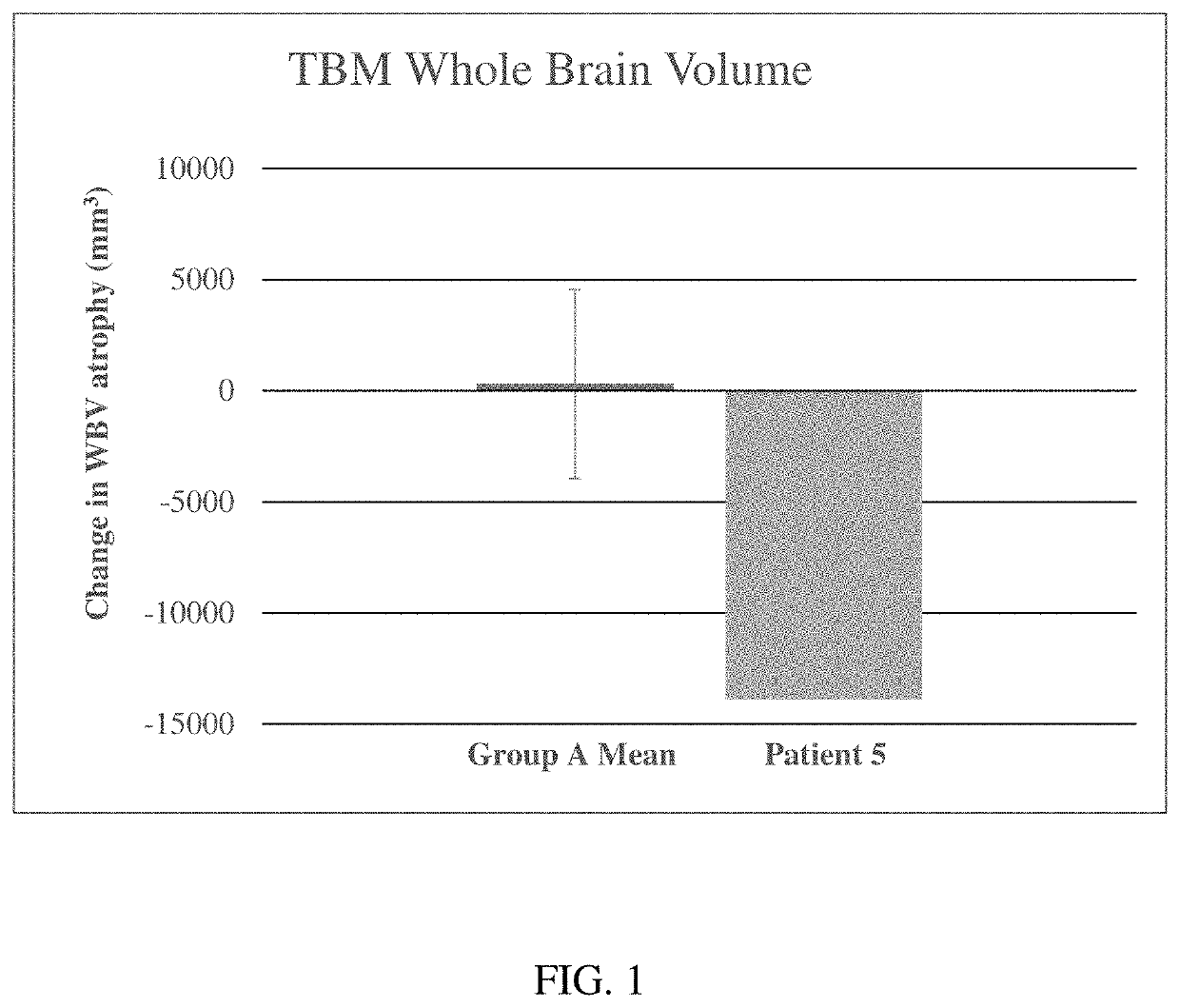Methods for treating neurological symptoms associated with lysosomal storage diseases
a lysosomal storage and neurological disease technology, applied in the field of neurological symptoms associated with lysosomal storage diseases, can solve the problems of difficult to predict which symptoms or disorders associated with each disease can be effectively treated with different treatment methods, accumulate toxic concentrations of glc, and so as to prevent or delay the loss of brain tissue volume, increase brain tissue volume, and increase the effect of brain tissue volum
- Summary
- Abstract
- Description
- Claims
- Application Information
AI Technical Summary
Benefits of technology
Problems solved by technology
Method used
Image
Examples
example 1
of Quinuclidine Compounds
1-azabicyclo[2.2.2]oct-3-yl [2-(4′-fluorobiphenyl-3-yl)propan-2-yl]carbamate (Compound 1)
[0584]Using General Procedure C, 1-azabicyclo[2.2.2]oct-3-yl [2-(3-bromophenyl)propan-2-yl]carbamate (600 mg, 1.63 mmol), 4-fluorophenyl boronic acid (457 mg, 3.27 mmol), and palladium (II) acetate gave the title compound as a white solid (373 mg; 60%). 1H NMR (400 MHz, CDCl3) δ 7.56 (s, 1H), 7.52 (dd, J=5.4, 8.4 Hz, 2H), 7.42-7.38 (m, 3H), 7.12 (m, 2H), 5.18 (5, 1H), 4.62 (s, 1H), 2.66 (m, 6H), 1.72 (s, 6H), 2.01-0.83 (m, 5H) ppm. 13C NMR (100 MHz, CDCl3) δ 125.0, 124.0, 123.8, 116.0, 116.0, 71.3, 55.9, 55.5, 47.6, 46.7, 29.6, 25.6, 24.8, 19.8 ppm. Purity: 98.0% UPLCMS (210 nm); retention time 0.95 min; (M+1) 382.9. Anal. Calcd. for C23H27FN2O2.0.37 (CHCl3): C, 65.86; H, 6.47; N, 6.57. Found: C, 65.85; H, 6.69; N, 6.49.
(S)-quinuclidin-3-yl 2-(2-(4-fluorophenyl)thiazol-4-yl)propan-2-ylcarbamate (Compound 2)
[0585]To a stirred solution of 4-fluorothiobenzamide (8.94 g, 57....
example 2
on of (S)-Quinuclidin-3-yl (2-(2-(4-fluorophenyl)thiazol-4-yl)propan-2-yl)carbamate free base
[0621]Step 1: Dimethylation with Methyl Iodide
[0622]A 3N round-bottom (RB) flask was equipped with a thermometer, an addition funnel, and a nitrogen inlet. The flask was flushed with nitrogen and potassium tert-butoxide (MW 112.21, 75.4 mmol, 8.46 g, 4.0 equiv., white powder) was weighed out and added to the flask via a powder funnel followed by the addition of THF (60 mL). Most of the potassium tert-butoxide dissolved to give a cloudy solution. This mixture was cooled in an ice-water bath to 0-2° C. (internal temperature). In a separate flask, the starting ester (MW 265.3, 18.85 mmol, 5.0 g, 1.0 equiv.) was dissolved in THF (18 mL+2 mL as rinse) and transferred to the addition funnel. This solution was added dropwise to the cooled mixture over a period of 25-30 min, keeping the internal temperature below 5° C. during the addition. The reaction mixture was cooled back to 0-2° C. In a separat...
example 3
on of Crystalline Forms of (S)-Quinuclidin-3-yl (2-(2-(4-fluorophenyl)thiazol-4-yl)propan-2-yl)carbamate salts
[0631]Crystalline salts of (S)-Quinuclidin-3-yl (2-(2-(4-fluorophenyl)thiazol-4-yl)propan-2-yl)carbamate may be formed from the free base prepared as described in Example 23.
[0632]For example, the free base of (S)-Quinuclidin-3-yl (2-(2-(4-fluorophenyl)thiazol-4-yl)propan-2-yl)carbamate (about 50 mmol) is dissolved IPA (140 ml) at room temperature and filtered. The filtrate is added into a 1 L RB flask which is equipped with an overhead stirrer and nitrogen in / outlet. L-malic acid (about 50 mmol) is dissolved in IPA (100+30 ml) at room temperature and filtered. The filtrate is added into the above 1 Liter flask. The resulting solution is stirred at room temperature (with or without seeding) under nitrogen for 4 to 24 hours. During this period of time, crystals form. The product is collected by filtration and washed with a small amount of IPA (30 ml). The crystalline solid is...
PUM
| Property | Measurement | Unit |
|---|---|---|
| time | aaaaa | aaaaa |
| time | aaaaa | aaaaa |
| time | aaaaa | aaaaa |
Abstract
Description
Claims
Application Information
 Login to View More
Login to View More - R&D
- Intellectual Property
- Life Sciences
- Materials
- Tech Scout
- Unparalleled Data Quality
- Higher Quality Content
- 60% Fewer Hallucinations
Browse by: Latest US Patents, China's latest patents, Technical Efficacy Thesaurus, Application Domain, Technology Topic, Popular Technical Reports.
© 2025 PatSnap. All rights reserved.Legal|Privacy policy|Modern Slavery Act Transparency Statement|Sitemap|About US| Contact US: help@patsnap.com



